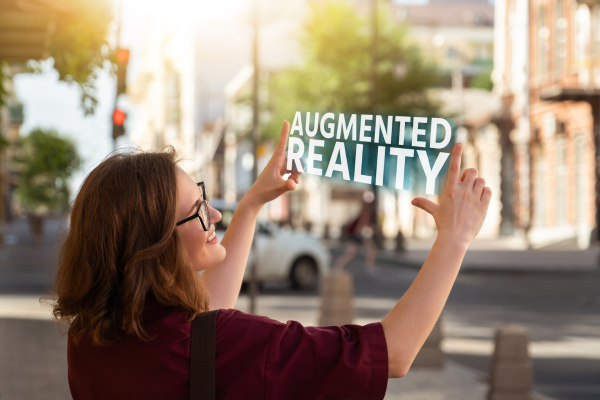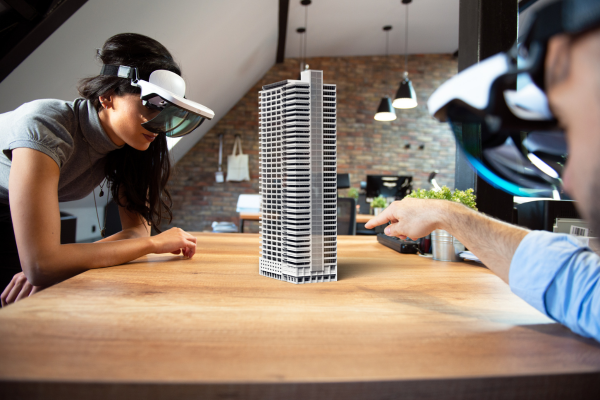
The Virtual Bridge: Transforming AEC with AR, VR, and BIM
In the world of building and design, connecting the dots between the first sketch and the final structure is crucial. Imagine having a magic wand that brings drawings to life, showing us how every beam fits and every room looks, even before the first brick is laid. This isn't fantasy—it's what happens when we mix the creativity of conceptual design with the precision of Building Information Modeling (BIM), all through a real-time collaborative platform. It's like a bridge that architects, engineers, and builders walk across together, making sure no detail is missed. In this journey, we're not just talking about constructing buildings; we're talking about constructing dreams, using tools that let us peek into the future. With technologies like Augmented Reality (AR) and Virtual Reality (VR) joining the party, this bridge becomes more than just a passage; it becomes a stage where every stakeholder has a front-row seat to innovation. So, let's dive into how this blend of art and science helps us build smarter, faster, and more creatively.
The world of building and creating spaces is always buzzing with new ideas. But even with all this creativity, the industry that shapes our homes and cities faces big challenges. Think of it like a team game where not everyone has the playbook, making it hard to score a win. The industry's growth and its slice of the global economy pie show its importance. Yet, we often hear about projects that stumble and fall, not because of bad ideas, but due to gaps in teamwork, communication, and managing risks.
Enter innovation, our hero, ready to shake things up. Building Information Modeling (BIM) is leading this charge, turning how we plan, build, and even think about projects on its head. Imagine having a digital twin of your project, where every detail, from a door handle to the slope of a roof, is mapped out and shared with the whole team in real-time. This isn't just about avoiding mistakes; it's about building better, together, and smarter.
Sadly, not everyone knows about these super tools, or how to use them, leaving many behind. It's clear the need for change isn't just wanted; it's required. As we push forward, embracing tech like BIM, along with the magic of AR and VR, we're not just fixing old problems. We're opening doors to a future where every building is a symphony of collaboration, precision, and innovation.
When we talk about bringing designs to life before the first stone is cast, integrating Augmented Reality (AR) and Virtual Reality (VR) with Building Information Modeling (BIM) is like adding wings to our creative visions. This trio of technologies is transforming the AEC industry, making collaboration, visualization, and decision-making not just easier, but more exciting.
Let’s start with AR. Imagine pointing your device at a construction site and seeing the future building in its place, or walking through a room and watching your ideas pop up on the actual walls. AR brings a layer of digital magic to the real world, allowing architects and clients to spot potential issues or changes that need to be made on the fly, literally overlaying the future onto the present.

Now, think of VR as your personal teleportation device. It whisks you away into a digital realm where you can walk through a building that's yet to exist. This isn't just about being wowed by the possibilities; it’s about stepping inside your project and experiencing it from every angle, ensuring that every element is just right. VR turns meetings into virtual explorations, bringing teams together inside their projects, no matter where they are in the world.
The beauty of combining AR, VR, and BIM is in how they complement each other. BIM provides the detailed models and information, AR gives us the power to superimpose these models onto the real world, and VR immerses us completely in the virtual version of our projects. Together, they offer a comprehensive view and understanding that was once hard to imagine.
This integration isn’t just cool tech; it’s practical. It means fewer mistakes, as problems can be spotted and solved before they become expensive fixes. It means better communication, as everyone involved can see and understand the vision. And it means more efficient projects, as decisions can be made quicker and with greater confidence. In essence, AR, VR, and BIM are not just tools for today’s AEC industry; they’re the foundation for tomorrow’s successes, where the only limit is our imagination.
Real-time collaboration in the AEC industry is changing the game. It's like when everyone in a band listens and plays in sync; the music just flows better. With technologies like BIM, AR, and VR, the building design and construction process become a harmonious orchestra, where every member plays their part flawlessly from anywhere in the world.

Imagine architects in New York, engineers in London, and clients in Tokyo, all walking through the same digital building, discussing changes, and making decisions on the spot. This isn't a scene from a sci-fi movie; it's what real-time collaboration tools make possible today. Tools that allow for this level of collaboration mean that the days of back-and-forth emails, costly mistakes, and delayed projects can become a thing of the past.
The impact of this can't be understated. When everyone involved in a project can see the same thing at the same time, regardless of their physical location, it leads to better communication, fewer errors, and a smoother workflow. Decisions can be made faster, designs can be tweaked in real time, and everyone stays on the same page. This level of cooperation brings projects to life quicker and more efficiently than ever before.
Moreover, this digital collaboration extends beyond the planning and design phases. It stretches into the construction phase, where builders on-site can access the most up-to-date plans and information, ensuring that what was agreed upon in the virtual world gets accurately translated into the real one. And with safety being a paramount concern in construction, these technologies offer innovative ways to train and prepare workers for the complexities of modern building sites.
In essence, real-time collaboration through BIM, AR, and VR is not just a technological advancement; it's a cultural shift in how we conceive, develop, and execute construction projects. It's about breaking down barriers, whether they're physical walls or time zones, to create a more connected, efficient, and innovative industry.
Looking into the future of the Architecture, Engineering, and Construction (AEC) industry, it's clear that the synergy between Augmented Reality (AR), Virtual Reality (VR), and Building Information Modeling (BIM) is not just a passing trend, but a major leap forward. Imagine a world where every construction project benefits from this powerful trio, making building designs more dynamic, efficient, and safe.
AR and VR will continue to bring BIM models to life, allowing for an even deeper level of immersion and understanding. This means fewer surprises during construction, as stakeholders can explore and tweak designs in a virtual environment before breaking ground. It’s like having a rehearsal for a building project, ensuring every part fits perfectly.
The future will also see these technologies making construction sites safer. By simulating various scenarios, workers can be trained in a risk-free virtual environment, preparing them for real-life challenges. This isn’t just about saving time and money; it’s about saving lives by reducing accidents.
As technology evolves, so will the accessibility of AR, VR, and BIM. What was once considered high-end will become standard, empowering even small firms to participate in the digital revolution of construction. The boundary between the digital and physical worlds will blur, leading to an era where our built environment is smarter, more sustainable, and more in tune with human needs.
In summary, the future of AEC lies in harnessing the full potential of AR, VR, and BIM synergy. It's a future where every project, from the smallest renovation to the largest skyscraper, benefits from enhanced visualization, collaboration, and safety. The journey there is exciting, filled with innovations that will transform not just how we build, but how we live and interact with our surroundings.
As we stand on the brink of a new era in the Architecture, Engineering, and Construction (AEC) industry, the integration of Augmented Reality (AR), Virtual Reality (VR), and Building Information Modeling (BIM) heralds a future filled with endless possibilities. These technologies are not just tools but catalysts for innovation, paving the way for smarter, safer, and more immersive construction processes. They promise a future where collaboration knows no bounds, where designs come to life before our eyes, and where every stakeholder can truly grasp the vision of a project. As we embrace these advancements, we're not just constructing buildings; we're crafting a new reality for the AEC industry, where every project is a masterpiece of efficiency, safety, and innovation. The journey ahead is exciting, and the potential is limitless. Let's build this future together.